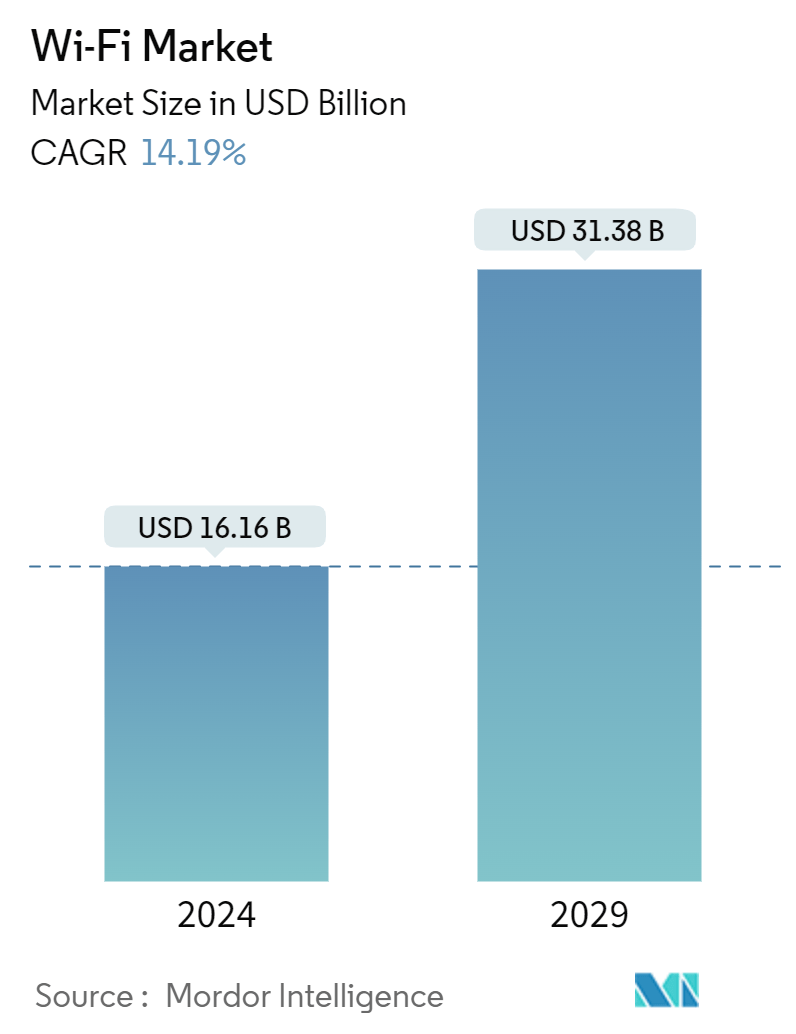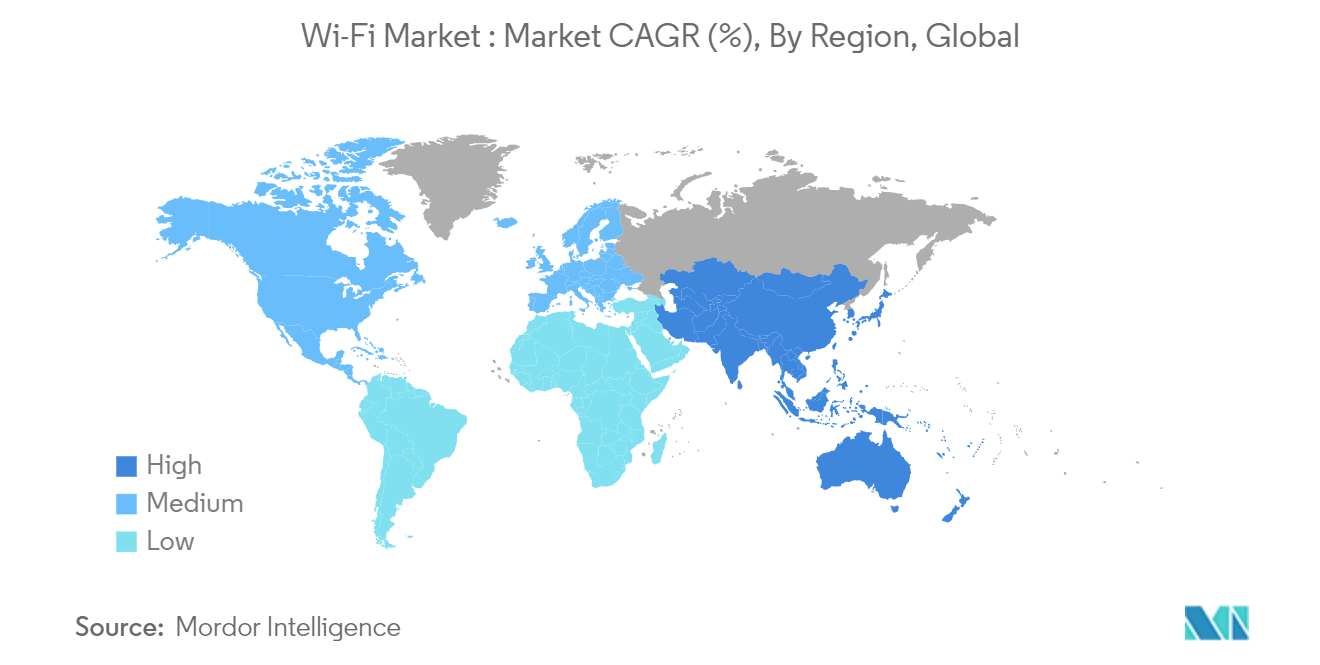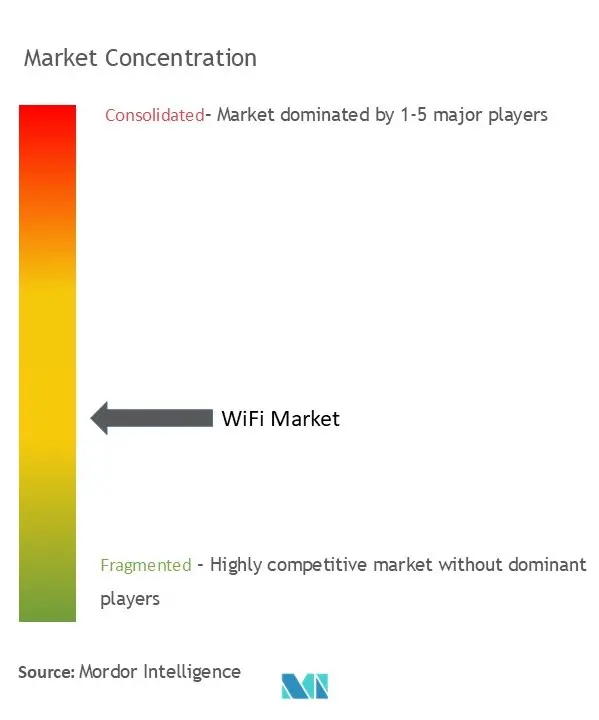WiFi Market Size

| Study Period | 2019 - 2029 |
| Market Size (2024) | USD 16.16 Billion |
| Market Size (2029) | USD 31.38 Billion |
| CAGR (2024 - 2029) | 14.19 % |
| Fastest Growing Market | Asia Pacific |
| Largest Market | North America |
Major Players
*Disclaimer: Major Players sorted in no particular order |
WiFi Market Analysis
The Wi-Fi Market size is estimated at USD 16.16 billion in 2024, and is expected to reach USD 31.38 billion by 2029, growing at a CAGR of 14.19% during the forecast period (2024-2029).
The Wi-Fi market is experiencing a significant transformation due to rising consumer demand and an evolving technological landscape. Wi-Fi technology has become indispensable in both consumer and business environments, powering everything from home Wi-Fi networks to large-scale enterprise solutions. As Wi-Fi routers and mesh systems continue to advance, they are shaping the future of wireless connectivity, particularly with the adoption of the Wi-Fi 6 standard. This new generation promises enhanced performance, faster speeds, and increased reliability in high-density environments, offering solutions to modern connectivity challenges.
Rise in Demand for Smart Consumer Electronics Devices
- Increasing Need for Seamless Connectivity: The surge in demand for smart consumer electronics is a major driver for Wi-Fi market growth. Consumers in North America, Europe, and Asia-Pacific increasingly rely on Wi-Fi-enabled devices like smartphones, tablets, smart home appliances, and wearables. This trend has fueled the expansion of home Wi-Fi networks, increasing the demand for robust Wi-Fi infrastructure across residential and commercial settings.
- Connectivity Across Devices: As households integrate smart lighting, security systems, and voice-controlled assistants, maintaining high-speed, reliable Wi-Fi becomes critical. Wi-Fi routers and mesh systems are essential in meeting the increasing connectivity needs of these interconnected devices.
- Entertainment and Work from Home: Streaming services, video conferencing, and cloud gaming are putting pressure on home networks. The rise in remote work and online entertainment has made Wi-Fi technology crucial for smooth, uninterrupted experiences in productivity and leisure activities.
- Wi-Fi 6 Driving Growth: The adoption of Wi-Fi 6 is a major trend in addressing bandwidth challenges created by multiple device usage. Wi-Fi 6 provides greater device density and faster data transmission, making it an ideal solution for today’s interconnected consumer electronics landscape.
Smart City Projects and Outdoor Wi-Fi Deployment
- Urban Connectivity Initiatives: Smart city projects are playing a significant role in the development of the Wi-Fi market. Cities across emerging regions such as Southeast Asia, the Middle East, and parts of Africa are deploying public Wi-Fi hotspots and advanced wireless network infrastructure to build connected urban environments. These projects are integral to broader digital transformation efforts, especially in regions aiming to enhance urban connectivity.
- Public Wi-Fi Access: Public Wi-Fi hotspots support smart city functions by offering enhanced connectivity for residents, tourists, and businesses. Urban Wi-Fi networks are essential for municipal services such as transportation, utilities, and public safety, further emphasizing the role of Wi-Fi in building smarter cities.
- Government Initiatives: National governments are heavily investing in Wi-Fi infrastructure to improve communication, enhance security, and foster economic development. By providing free or subsidized Wi-Fi in public spaces like parks, libraries, and transport hubs, governments are ensuring connectivity across urban and rural areas.
- Partnerships with Industry Leaders: Public-private partnerships are key to the success of smart city projects. Industry giants like Cisco, Ericsson, and Huawei are collaborating with local governments to deploy Wi-Fi infrastructure and offer technological support. This cooperation strengthens the development of Wi-Fi connectivity solutions in smart urban settings.
Ongoing Technological Advancements in Wi-Fi
- Enhanced Capabilities of Wi-Fi 6: Wi-Fi technology has evolved significantly with the emergence of Wi-Fi 6, which has become a game changer in the wireless network market. Wi-Fi 6 offers critical enhancements that make it suitable for a wide range of applications, from residential to large-scale enterprise Wi-Fi networks.
- Faster Data Transmission: Wi-Fi 6 enables faster data transfers, reduced latency, and improved performance in congested networks. This resolves many of the bandwidth limitations experienced by previous Wi-Fi generations, especially in environments with high device density.
- Higher Device Capacity: One of Wi-Fi 6’s major advantages is its ability to handle more devices without compromising on network speed or stability. This feature is particularly valuable in high-density environments like stadiums, conference centers, and smart cities, where seamless connectivity is essential.
- Energy Efficiency Improvements: Wi-Fi 6 introduces new energy-saving features that enhance the efficiency of IoT devices and other battery-powered electronics. This results in longer battery life, which is especially crucial for enterprises adopting large-scale Wi-Fi solutions.
WiFi Market Trends
Rising Demand for Indoor Wi-Fi Solutions to Drive the Market
- Rising Demand for Indoor Wi-Fi Solutions: The Wi-Fi market is rapidly evolving as more consumers and businesses demand high-speed, uninterrupted connectivity. Two of the most significant trends include the growing dominance of indoor Wi-Fi networks and the accelerated adoption of Wi-Fi technology in the Asia-Pacific region.
- Indoor Wi-Fi Networks Drive Growth: With the increasing integration of IoT devices and smart home technologies, indoor Wi-Fi networks have become essential. Consumers and businesses alike are investing in advanced Wi-Fi routers and infrastructure to meet the connectivity demands of modern homes, offices, and public spaces.
- Wi-Fi Mesh Systems: Wi-Fi mesh systems, which offer seamless internet access in larger or more complex spaces, are gaining popularity. These systems eliminate dead zones and ensure stable connectivity, supporting the growing number of connected devices in homes and enterprises.
- Enhanced Wi-Fi Security Standards: As more devices connect to Wi-Fi networks, security has become a top concern. Stronger Wi-Fi security protocols are being introduced to protect sensitive data and prevent cyberattacks. These security enhancements are particularly crucial for enterprise Wi-Fi networks and smart home solutions.

Asia-Pacific to Witness the Fastest Growth in Wi-Fi Market
- Urbanization and Internet Penetration: The Asia-Pacific region is expected to experience the fastest growth in the Wi-Fi market, driven by increasing internet penetration and rapid urbanization. Major economies like China, India, Japan, and South Korea are heavily investing in Wi-Fi infrastructure to support the rising demand for wireless solutions.
- Adoption of Wi-Fi 6: Asia-Pacific’s rapid adoption of Wi-Fi 6 is a significant driver of market growth. The technology’s faster speeds and improved device-handling capacity make it ideal for the densely populated cities in the region. This adoption is particularly beneficial for industries like healthcare, education, and manufacturing.
- Expansion of Connected Devices: With a surge in smartphone, tablet, and IoT device usage, the region’s need for robust home Wi-Fi and public Wi-Fi networks has intensified. E-commerce and online entertainment sectors are booming, driving demand for reliable internet access.
- Government Initiatives: Governments across Asia-Pacific are actively supporting the expansion of Wi-Fi infrastructure. For instance, India’s Smart Cities initiative focuses on increasing public Wi-Fi availability, while South Korea leads in integrating Wi-Fi with 5G networks. These initiatives are expected to sustain the region’s rapid Wi-Fi market growth.

WiFi Industry Overview
Semi Consolidated Market: The global Wi-Fi market is characterized by a semi consolidated structure, where a few dominant global players lead the innovation and infrastructure development. Companies like Cisco Systems Inc., Aruba Networks (HP Enterprise), and CommScope (Ruckus Networks) are at the forefront, offering advanced Wi-Fi solutions that cater to diverse consumer and enterprise needs.
Global Market Leaders: Cisco Systems Inc., Aruba Networks, Juniper Networks, CommScope, and Ericsson are the key players shaping the Wi-Fi market. Cisco’s extensive portfolio in networking hardware and software solutions, along with Aruba’s excellence in managed services, has positioned these companies as industry leaders. Juniper Networks and Ericsson contribute with their expertise in integrated Wi-Fi solutions.
Future Trends: Wi-Fi 6 and 6E technologies are leading future innovations, improving speed, efficiency, and security. In addition, smart cities and the demand for high-speed connectivity in both urban and rural areas are expected to drive market growth. Companies that focus on cloud-based networking, enhanced security, and cost-effective enterprise solutions will remain competitive.
WiFi Market Leaders
-
Cisco Systems Inc.
-
Aruba Networks (HP Enterprise)
-
CommScope (Ruckus Networks (Arris International))
-
Juniper Networks Inc.
-
Telefonaktiebolaget LM Ericsson
*Disclaimer: Major Players sorted in no particular order

WiFi Market News
- September 2024 - Huawei takes the lead in the global Wi-Fi market by being the first to release a new Wi-Fi 7 product, signaling a shift from connected networking to experiential networking in campus networks. The company is set to launch its "Nebula Plan" nationwide, aimed at upgrading high-quality networks, as part of its strategy to capitalize on China's growing digital economy and the intergenerational upgrade in data communication.
- September 2024 - CommScope's RUCKUS Networks has partnered with Nokia to develop an integrated fiber and Wi-Fi solution for seamless in-building and campus-wide connectivity, targeting various industries including MDUs, offices, large venues, hospitality, and medical facilities. This collaboration combines Nokia's Optical LAN technology with RUCKUS Networks' enterprise Wi-Fi and switching technologies, aiming to create a comprehensive campus connectivity solution that promises reduced energy costs, lower total cost of ownership, and improved sustainability for enterprises in the global Wi-Fi market.
WiFi Market Report - Table of Contents
1. INTRODUCTION
- 1.1 Study Assumptions and Market Definition
- 1.2 Scope of the Study
2. RESEARCH METHODOLOGY
3. EXECUTIVE SUMMARY
4. MARKET INSIGHT
- 4.1 Market Overview
-
4.2 Industry Attractiveness - Porter's Five Forces Analysis
- 4.2.1 Bargaining Power of Suppliers
- 4.2.2 Bargaining Power of Buyers
- 4.2.3 Threat of New Entrants
- 4.2.4 Threat of Substitutes
- 4.2.5 Intensity of Competitive Rivalry
- 4.3 Industry Value Chain Analysis
- 4.4 Impact of COVID-19 on the Wi-Fi Industry (Recent Changes in Work Environment has Led to Increasing Demand for Indoor Wi-Fi Products and the Impact of BYOD Trends)
- 4.5 Evolution of Wi-Fi Standards and Regulations
5. MARKET DYNAMICS
-
5.1 Market Drivers
- 5.1.1 Rise in Demand for Smart Consumer Electronics Devices
- 5.1.2 Smart City Projects and Outdoor Wi-Fi Deployment
- 5.1.3 Ongoing Technological Advancements in Wi-Fi
-
5.2 Market Challenges
- 5.2.1 Stringent Government Guidelines and Data Regulations
- 5.2.2 Operational Challenges in Denser Environments
- 5.2.3 Concerns Related to Implementation in Outdoor Areas
6. MARKET SEGMENTATION
-
6.1 By Product Type
- 6.1.1 Access Points
- 6.1.2 Gateways
- 6.1.3 Routers and Extenders
- 6.1.4 Services (Design, Implementation, and Support)
- 6.1.5 Other Device Types
- 6.1.6 Other Solutions
-
6.2 By Application Type
- 6.2.1 Indoor (Residential, Enterprises, Education)
- 6.2.2 Outdoor (Public Services, Transportation, Public Utilities, Etc.)
-
6.3 By Geography
- 6.3.1 North America
- 6.3.1.1 United States
- 6.3.1.2 Canada
- 6.3.2 Europe
- 6.3.2.1 United Kingdom
- 6.3.2.2 Germany
- 6.3.2.3 France
- 6.3.2.4 Rest of Europe
- 6.3.3 Asia Pacific
- 6.3.3.1 China
- 6.3.3.2 Japan
- 6.3.3.3 South Korea
- 6.3.3.4 Rest of Asia-Pacific
- 6.3.4 Latin America
- 6.3.5 Middle East and Africa
7. COMPETITIVE LANDSCAPE
-
7.1 Company Profiles*
- 7.1.1 Cisco Systems Inc.
- 7.1.2 Aruba Networks (HP Enterprise)
- 7.1.3 CommScope (Ruckus Networks (Arris International))
- 7.1.4 Juniper Networks Inc.
- 7.1.5 Telefonaktiebolaget LM Ericsson
- 7.1.6 Huawei Technologies Co. Ltd
- 7.1.7 Aerohive Networks (Extreme Networks)
- 7.1.8 MetTel Inc.
- 7.1.9 Cloud4Wi Inc.
- 7.1.10 Fortinet Inc.
- 7.1.11 Purple Wi-Fi Ltd
- 7.1.12 SingTel
- 7.1.13 Ubiquiti Inc.
- 7.1.14 Motorola Solutions Inc.
- 7.1.15 New H3C Technologies Co. Ltd
8. INVESTMENT ANALYSIS
9. FUTURE OF THE MARKET
** Subject To AvailablityWiFi Industry Segmentation
Wi-fi is a trademarked term that denotes wi-fi-certified WLAN-based connectivity products that enable communication for various devices over the internet. The recent rise in the number of devices connected over the internet and the demand for external wi-fi communication has significantly driven the need for these connectivity products. The study focuses on tracking the market growth and forecasts for various products, such as access points, gateways, extenders, routers, and services. The study analyzes the evolution of Wi-Fi-based communication that has led to the recent launch of Wi-Fi 6, which is touted as the next-generation standard in the technology.
Wi-Fi market is segmented by product (access points, gateways, routers, and extenders), application (residential, enterprise, and education), outdoor (public services, transportation, and public utilities), and geography (North America (United States, Canada), Europe (Germany, United Kingdom, France, rest of Europe), Asia-Pacific (China, Japan, South Korea, rest of Asia-Pacific) and Latin America and Middle East and Africa). The market sizes and forecasts are provided in terms of value (USD) for all the above segments.
| By Product Type | Access Points | |
| Gateways | ||
| Routers and Extenders | ||
| Services (Design, Implementation, and Support) | ||
| Other Device Types | ||
| Other Solutions | ||
| By Application Type | Indoor (Residential, Enterprises, Education) | |
| Outdoor (Public Services, Transportation, Public Utilities, Etc.) | ||
| By Geography | North America | United States |
| Canada | ||
| By Geography | Europe | United Kingdom |
| Germany | ||
| France | ||
| Rest of Europe | ||
| By Geography | Asia Pacific | China |
| Japan | ||
| South Korea | ||
| Rest of Asia-Pacific | ||
| By Geography | Latin America | |
| Middle East and Africa |
WiFi Market Research FAQs
How big is the Wi-Fi Market?
The Wi-Fi Market size is expected to reach USD 16.16 billion in 2024 and grow at a CAGR of 14.19% to reach USD 31.38 billion by 2029.
What is the current Wi-Fi Market size?
In 2024, the Wi-Fi Market size is expected to reach USD 16.16 billion.
Who are the key players in Wi-Fi Market?
Cisco Systems Inc., Aruba Networks (HP Enterprise), CommScope (Ruckus Networks (Arris International)), Juniper Networks Inc. and Telefonaktiebolaget LM Ericsson are the major companies operating in the Wi-Fi Market.
Which is the fastest growing region in Wi-Fi Market?
Asia Pacific is estimated to grow at the highest CAGR over the forecast period (2024-2029).
Which region has the biggest share in Wi-Fi Market?
In 2024, the North America accounts for the largest market share in Wi-Fi Market.
What years does this Wi-Fi Market cover, and what was the market size in 2023?
In 2023, the Wi-Fi Market size was estimated at USD 13.87 billion. The report covers the Wi-Fi Market historical market size for years: 2019, 2020, 2021, 2022 and 2023. The report also forecasts the Wi-Fi Market size for years: 2024, 2025, 2026, 2027, 2028 and 2029.
WiFi Industry Report
Wi-Fi Market Research
Our comprehensive Wi-Fi market research report provides in-depth insights into the key drivers, trends, and technological advancements shaping the wireless network industry. The report delves into the growing demand for home Wi-Fi networks, the adoption of Wi-Fi 6 technology, and the role of public Wi-Fi hotspots in smart city projects. Additionally, it covers the competitive landscape and future trends, including security enhancements and mesh systems. Industry stakeholders will find value in the detailed analysis of Wi-Fi infrastructure investments across North America, Europe, and Asia-Pacific, as well as in emerging regions like Southeast Asia and the Middle East.
This research delivers actionable data to guide decision-makers in optimizing their Wi-Fi strategies. With insights on market segmentation, industry statistics, and technology forecasts, the report equips businesses and governments to adapt to evolving connectivity needs. From enterprise Wi-Fi solutions to home network innovations, all insights are available in an easy-to-read report pdf, offering stakeholders a complete overview of the market's future direction.



